See Jupiter in the Daytime, the Evening Moon Meets Many Planets, and then Exhibits an X on Saturday!
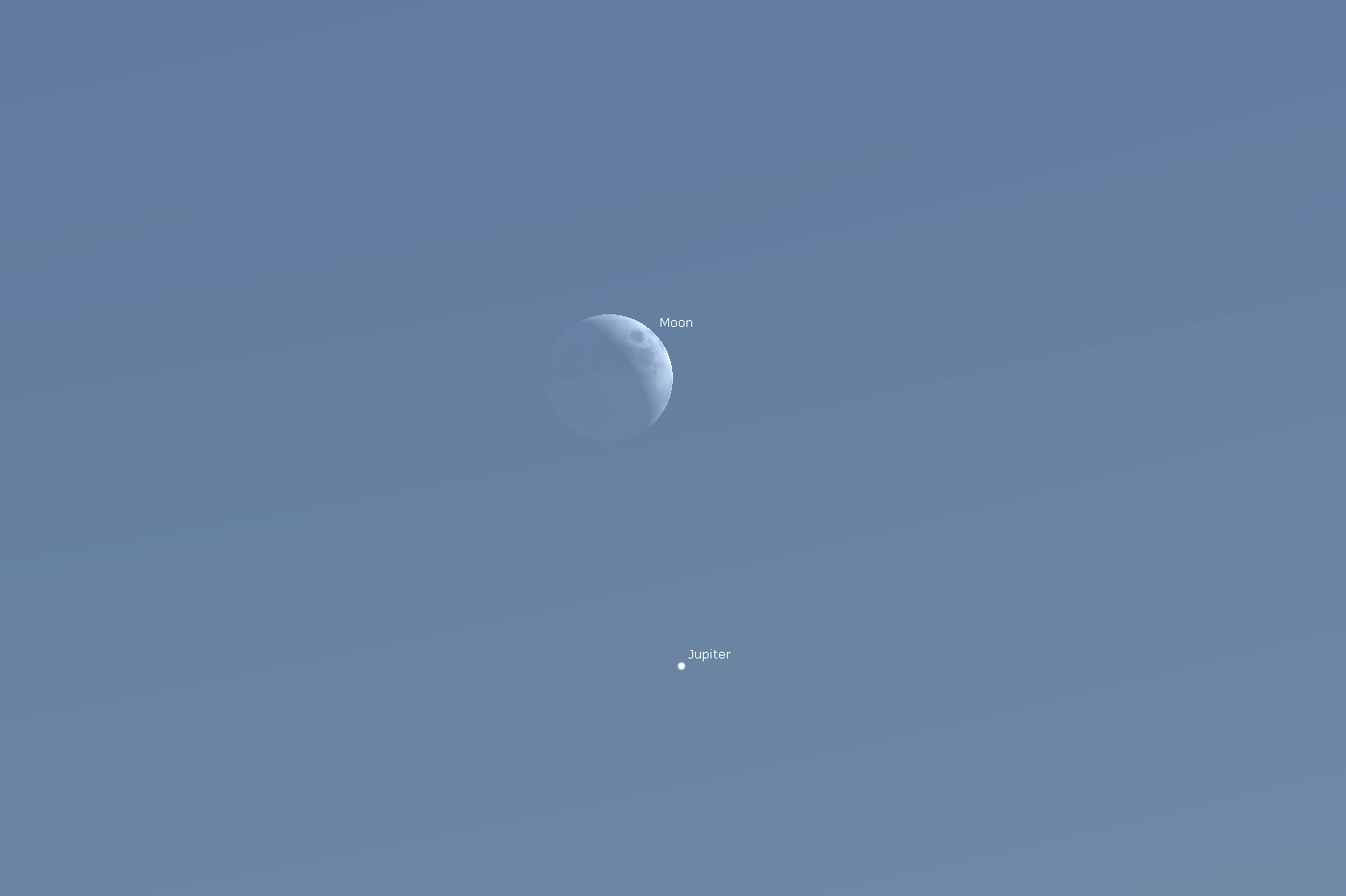
On Thursday, October 3, the moon will guide you to see nearby Jupiter in daytime. This correctly oriented view for 3 pm EDT (00:19 GMT) simulates what binoculars will show. The planet is visible without binoculars, too. Look for a tiny, brilliant point of light below the moon.
Hello, Early Autumn Stargazers!
Here are your Astronomy Skylights for the week of September 29th, 2019 by Chris Vaughan. Feel free to pass this along to your friends and send me your comments, questions, and suggested topics. I repost these emails with photos at http://astrogeo.ca/skylights/ where all the old editions will be archived. You can also follow me on Twitter as @astrogeoguy! Unless otherwise noted, all times are Eastern Time. Please click this MailChimp link to subscribe to these emails.
I can bring my Digital Starlab portable inflatable planetarium to your school or other daytime or evening event. Contact me through AstroGeo.ca, and we’ll tour the Universe together!
For those who have been reading my Skylights on Tumblr, I am now migrating the content to my website, where I can better control the size of the photos and sky charts. The page where the Skylights are listed is located at http://astrogeo.ca/skylights/. We’re still ironing out the site, so let me know if you have any comments or suggestions.
The Moon and Planets, and a Lunar X
This is the week of the lunar month when our natural satellite is best positioned for after-dinner viewing AND at looking its most picturesque. The moon will visit the four brightest planets this week and sport the famous Lunar X. Keep your binoculars and telescopes handy – here are the Skylights!
Tonight (Sunday), the very young crescent moon will sit a palm’s width above, and between, Mercury (on the lower left) and Venus (on the lower right. The trio will be embedded in the evening twilight, but you can hunt down all three objects in binoculars, once the sun has completely disappeared from below the horizon. Start looking immediately after sunset – the planets will set within about 20 minutes, at about 7:30 pm local time. The moon will follow about half an hour later. Observers at southerly latitudes will see them more clearly, in a darker sky.

For the rest of this week, the moon will wax in phase and climb higher as it shifts east away from the sun. On Monday and Tuesday evening it will pass in front of the stars of Libra (the Scales). By the way – don’t forget that the stars are incredibly far away and the planets are in the “foreground”. Even though stars are sprinkled within a three-dimensional volume of space that is entirely within our Milky Way galaxy, they appear be fixed in place – like the pattern on cosmic wallpaper. The moon and planets are much, much closer – and re-arrange themselves – as furniture in a large room can be. Even that analogy fails to convey the difference in the distances. For example, the stars around Jupiter are several million times farther away than the planet!
Once we get to mid-week the moon will be nice and high in a dark sky – perfect for telescope viewing. As the moon waxes fuller, the sun is rising over the moon’s eastern horizon. Locations along the terminator, which is the pole-to-pole line that separates the lit and dark hemispheres, are seeing the sun peek above the moon’s horizon. The near-horizontal sunlight arriving there casts long black shadows to the west and illuminates any elevated mountain, crater, ridge, or bump.
Every night, the terminator shifts west, casting new parts of the moon into breathtaking relief. So there’s something new to see every night.
On Thursday, the almost half-illuminated moon will be located a finger’s width from Jupiter. The moon and Jupiter will easily fit together within the field of view of binoculars or a backyard telescope at low magnification. This conjunction will offer an excellent opportunity to see Jupiter in the daytime, too – using the moon as a reference. In mid-afternoon, Jupiter will be directly below the moon. It will appear as a tiny bright point of light to your unaided eyes, a tiny disk in binoculars. Telescopes will work, too! Later, in the evening, the moon will have moved slightly farther away from Jupiter, and will sit to the upper left (or to the celestial northeast) of it.
But the moon has one more planet to visit before the week is done. On Saturday afternoon, the moon will complete one quarter of its orbit around Earth (counting from the last new moon) and will reach its first quarter phase. At first quarter, the moon always appears half-illuminated on its right-hand, eastern side. It rises around noon local time. Look for yellowish Saturn sitting less than two finger widths to the upper right (or to the celestial northwest) of the moon. The moon and Saturn will fit together into the field of view of binoculars and backyard telescopes at low magnification. Observers in southern Africa will get to see the moon occult Saturn. It does this fairly often.
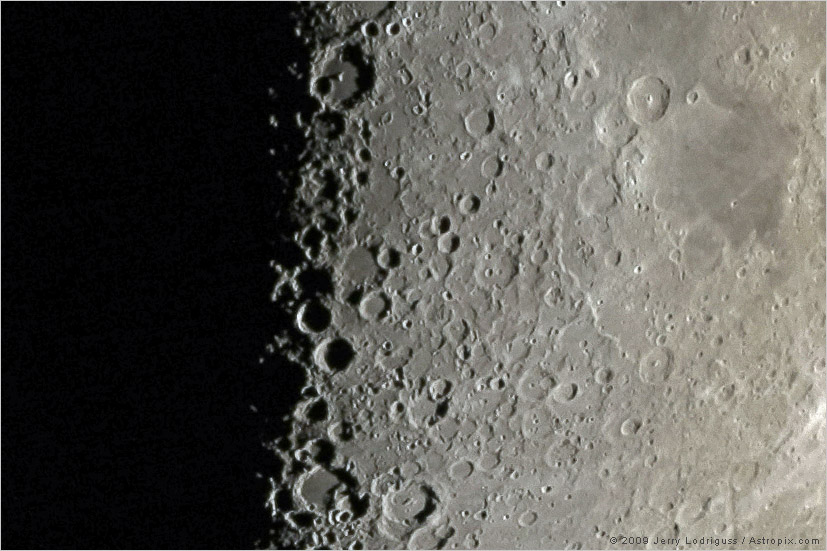
Several times a year at the moon’s first quarter phase, a feature called the Lunar X becomes visible in strong binoculars and small telescopes. For a few hours centered on approximately 11 pm EDT on Saturday, October 5, the illuminated rims of the craters Purbach, la Caille, and Blanchinus will combine to form a small, but very obvious X-shape. Using binoculars or a backyard telescope, look for the X along the terminator, and about one third of the way up from the southern pole of the moon (at lunar coordinates 2° East, 24° South).
As I mentioned earlier, Mercury and Venus are near the setting sun. They are currently shifting farther from the sun, but the shallow ecliptic will prevent them from climbing above the glare of sunset for a while longer. This week, you might be able to see Mercury and Venus sitting very low in the west for about 20 minutes after the sun disappears. Tonight (Sunday), Mercury will be positioned about a palm’s width to the left (celestial east) of Venus. It will increase that separation all this week. Observers near the equator and in the Southern Hemisphere will see those two inner planets very easily during the next couple of weeks.
The earlier-arriving sunsets of September is allowing us to view spectacularly bright Jupiter well, even though the planet is steadily being carried west towards the sun. As the sky begins to darken this week, look for the giant planet sitting less than a quarter of the way up the southwestern sky. Hour by hour, Jupiter will sink lower – then set in the west by about 10 pm local time. Jupiter has spent this entire year below the stars of Ophiuchus (the Serpent-Bearer) and above Scorpius (the Scorpion).
On a typical night, even a backyard telescope will show you Jupiter’s two main equatorial stripes and its four Galilean moons – Io, Europa, Callisto, and Ganymede looking like small white dots arranged in a rough line flanking the planet. Good binoculars will show the moons, too! If you see fewer than four dots, then the others are in front of Jupiter, or hidden behind it. Or, it might be that some moons are not being illuminated by sunlight because they are in eclipse!
Due to Jupiter’s rapid 10-hour rotation period, the Great Red Spot (or GRS) is only observable from Earth every 2nd or 3rd night, and only during a predictable three-hour window. The GRS will be easiest to see using a medium-sized, or larger, aperture telescope on an evening of good seeing (steady air). If you’d like to see the Great Red Spot in your telescope, it will be crossing the planet on Tuesday evening from 7 to 10 pm EDT, and on Sunday, October 6 from dusk to 9:15 pm EDT – with the black shadow of Io.
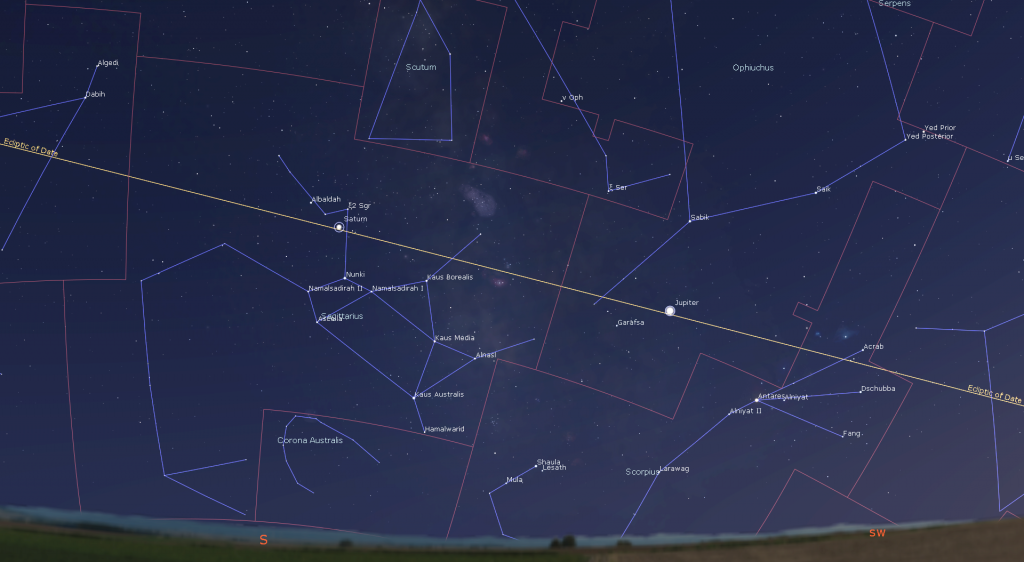
Yellow-tinted Saturn is prominent in the southern evening sky, too – but it is much less bright than Jupiter. The ringed planet will be visible from dusk, when it will be about 2.5 fist diameters above the southern horizon, until about midnight local time. Saturn’s position in the stars is just to the upper left (or celestial east) of the stars that form the teapot-shaped constellation of Sagittarius (the Archer).
Saturn is well worth dusting off your old telescope! Once the sky is dark, even a small telescope will show Saturn’s rings and several of its brighter moons, especially Titan! Because Saturn’s axis of rotation is tipped about 27° from vertical (a bit more than Earth’s axis), we can see the top surface of its rings, and its moons can arrange themselves above, below, or to either side of the planet. During this week, Titan will migrate counter-clockwise around Saturn, moving from the upper right of Saturn tonight (Sunday) to the left of the planet next Sunday. (Remember that your telescope will flip the view around.)
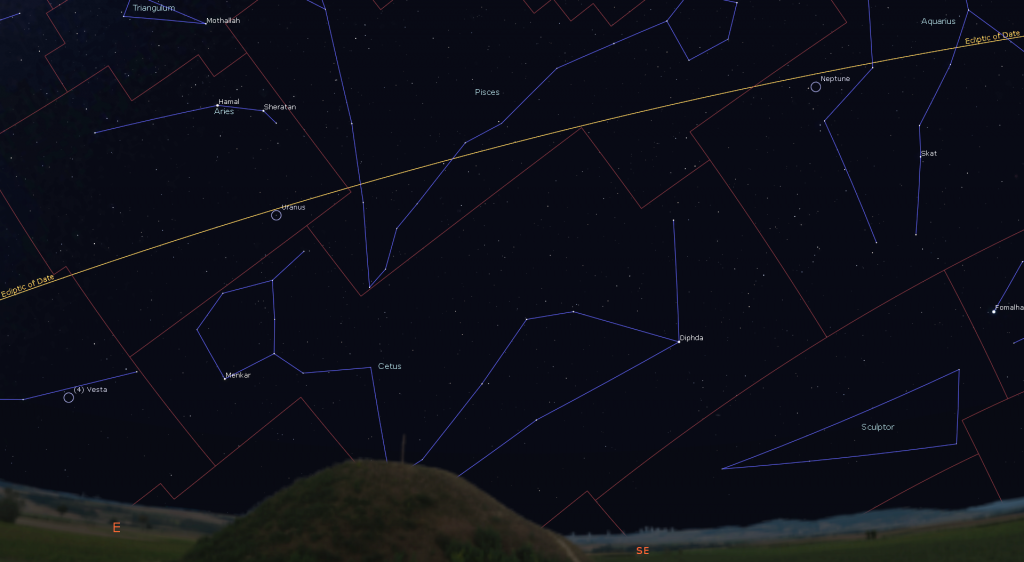
Blue-green Uranus will be rising in the east just before 8 pm local time this week; and it will remain visible all night long. The planet is sitting below (or to the celestial south of) the stars of Aries (the Ram) and is just a palm’s width above the circlet of stars that form the head of Cetus (the Whale). At magnitude 5.7, Uranus is actually bright enough to see in binoculars and small telescopes, under dark skies. You can use the three modest stars that form the top of the head of the whale (or sea-monster in some tales) to locate Uranus for the next several months. That’s because the distant planet moves so slowly in its orbit.
Distant, blue Neptune is still more or less at its closest to Earth for the year. The dim, magnitude 7.8, blue planet is visible all night long among the stars of eastern Aquarius, less than a finger’s width to the right (or celestial west) of a medium-bright star named Phi (φ) Aquarii. Both blue Neptune and that golden-coloured star will appear together in the field of view of a backyard telescope at medium power. The distance between the star and the planet is steadily increasing due to Neptune’s westward retrograde orbital motion. I posted a diagram of Neptune’s position compared to that star here.
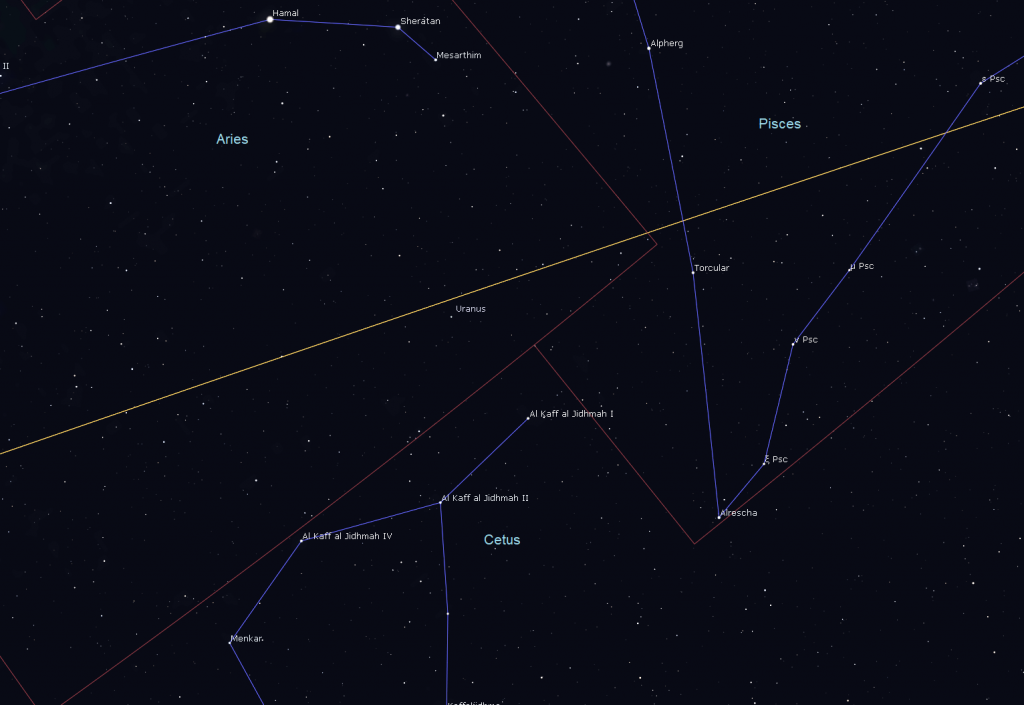
Mars is now pulling away from the sun’s glare in the eastern pre-dawn sky. It rises at about 6:20 am local time and will become more easily visible later this month. Unfortunately, the red planet is on the far side of the sun from us – so it will remain rather small and faint until early next year. I’ll post sky charts for all the observable planets here.
Zodiacal Light
During moonless mornings in September and October, the steep morning ecliptic favors the appearance of the zodiacal light in the eastern sky for about half an hour before dawn. The glow is sunlight reflected from interplanetary particles drifting in the plane of our solar system. During this week, look east, below the stars of Leo (the Lion), for a broad wedge of faint light rising from the horizon and centered on the ecliptic. (The ecliptic passes directly through the bright star Regulus in Leo.) Don’t confuse the zodiacal light with distant light pollution, or the Milky Way, which is sitting further to the southeast. I posted a picture n last week’s Skylights, which are posted here.
Seeing Giant Galaxies
If you missed last week’s information about seeing a galaxy with your own eyes, I posted it here.
Public Astro-Themed Events
Taking advantage of the moon and bright planets in the sky this week, the RASC Toronto Centre astronomers will hold their free monthly public City Sky Star Party in Bayview Village Park (steps from the Bayview subway station), starting around 8 pm on the first clear weeknight this week (Mon to Thu only). You don’t need to be an RASC member, or own any equipment, to join them – looks are free! Check here for details, and check the banner on their website home page or Facebook page for the GO or NO-GO decision around 5 pm each day.
Every Monday evening, York University’s Allan I. Carswell Observatory runs an online star party – broadcasting views from four telescopes/cameras, answering viewer questions, and taking requests! Details are here. On Wednesday nights they offer free public viewing through their rooftop telescopes. If it’s cloudy, the astronomers give tours and presentations. Details are here.
On Wednesday, October 2 at 7 pm, the Perimeter Institute in Waterloo will present a free public talk and live webcast by Astronomer Royal Sir Martin Rees, who will address On the Future: Prospects for Humanity. Registration and details are here.
If the skies are clear on Thursday evening, October 3, local astronomers will set up their telescopes in Thornhill. This free event starts at 7:30 pm and everyone is welcome to come out for a look at the Moon, Jupiter and Saturn, and a variety of deep-sky treasures. The viewing location is the soccer field beside the tennis courts at Pomoma Valley Tennis Club on John St. There is plenty of parking.
Eastern GTA sky watchers are invited to join the RASC Toronto Centre and Durham Skies for solar observing and stargazing at the edge of Lake Ontario in Millennium Square in Pickering on Friday evening, October 4, from 6 pm to 11 pm. Details are here. Before heading out, check the RASCTC home page for a Go/No-Go call in case it’s too cloudy to observe. The rain date is Saturday.
If it’s sunny on Saturday morning, October 5 from 10 am to noon, astronomers from the RASC Toronto Centre will be setting up outside the main doors of the Ontario Science Centre for Solar Observing. Come and see the Sun in detail through special equipment designed to view it safely. This is a free event (details here), but parking and admission fees inside the Science Centre will still apply. Check the RASC Toronto Centre website or their Facebook page for the Go or No-Go notification.
The Science Centre will also host an evening star party on Saturday, October 5 from 6 to 8 pm, weather permitting. Details are here.
The next RASC-hosted Night at the David Dunlap Observatory will be on Saturday, October 19. There will be sky tours in the Skylab planetarium room, space crafts, a tour of the giant 74” telescope, and viewing through the 74” and lawn telescopes (weather permitting). The doors will open at 8:30 pm for a 9 pm start. Attendance is by tickets only, available here. If you are a RASC Toronto Centre member and wish to help us at DDO in the future, please fill out the volunteer form here. And to join RASC Toronto Centre, visit this page.
This Fall and Winter, spend a Sunday afternoon in the other dome at the David Dunlap Observatory! On Sunday afternoon, October 20, from noon to 4 pm, join me in my Starlab Digital Planetarium for an interactive journey through the Universe at DDO. We’ll tour the night sky and see close-up views of galaxies, nebulas, and star clusters, view our Solar System’s planets and alien exo-planets, land on the moon, Mars – and the Sun, travel home to Earth from the edge of the Universe, hear indigenous starlore, and watch immersive fulldome movies! Ask me your burning questions, and see the answers in a planetarium setting – or sit back and soak it all in. Sessions run continuously between noon and 4 pm. Ticket-holders may arrive any time during the program. The program is suitable for ages 3 and older, and the Starlab planetarium is wheelchair accessible. For tickets, please use this link.
Keep looking up, and enjoy the sky when you do. I love questions and requests – so, send me some!